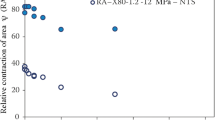It was established that the metal of long-term operated gas pipelines made of 10G2BT steel contains relatively little hydrogen, which does not create prerequisites for the pipes hydrogen embrittlement. However, for the considered cases, it was established that the microstructure of steel is characterized by increased defectiveness, which increases with the extension of the pipeline operation time. Such a defective microstructure has an increased ability of absorbing hydrogen, and therefore there is a risk of hydrogen embrittlement of the material. It was concluded that the use of long-term operated pipelines for transportation mixtures of natural gas and hydrogen without additional verification is problematic.




Similar content being viewed by others
References
H. Nykyforchyn, “In-service degradation of pipeline steels. Degradation Assessment and Failure Prevention of Pipeline Systems,” in: G. Bolzon, G. Gabetta, H. Nykyforchyn (Ed.), Lecture Notes in Civil Eng., Springer, Cham. Vol. 102 (2021), pp. 15–29. https://doi.org/10.1007/978-3-030-58073-5_2.
M. Askari, M. Aliofkhazraei, and S. Afroukhteh, “A comprehensive review on internal corrosion and cracking of oil and gas pipelines,” J. of Natural Gas Sci. and Eng., 71, art. no. 102971 (2019). https://doi.org/10.1016/j.jngse.2019.102971
Y. F. Cheng, Stress corrosion cracking of pipelines, John Wiley & Sons, Inc., New York (2013). https://doi.org/10.1002/9781118537022
E. I. Kryzhanivs’kyi, R. S. Hrabovs’kyi, and O. Y. Vytyaz’, “Influence of the geometry of corrosion-fatigue cracks on the residual service life of objects intended for long-term operation,” Mater. Sci., 54, No. 5, 647–655 (2019). https://doi.org/10.1007/s11003-019-00229-8.
O. I. Zvirko, S. F. Savula,V. M. Tsependa, G. Gabetta, and H. M. Nykyforchyn, “Stress-corrosion cracking of gas pipeline steels of different strength,” Proc. Struct. Int., 2, 509–516 (2016). https://doi.org/10.1016/j.prostr.2016.06.066
L. Nyrkova, “Stress-corrosion cracking of pipe steel under complex influence of factors,” Eng. Fail. Anal., 116, art. no. 104757 (2020). https://doi.org/10.1016/j.engfailanal.2020.104757
A. M. Syrotyuk, and I. M. Dmytrakh, “Methods for the evaluation of fracture and strength of pipeline steels and structures under the action of working media. Part I. Influence of the corrosion factor,” Mater. Sci., 50, No. 3, 324–339 (2014). https://doi.org/10.1007/s11003-014-9724-5
I. M. Dmytrakh, A. M. Syrotyuk, and R. L. Leshchak, “Specific features of electrochemical hydrogenation of low-alloy pipeline steel in a model solution of ground water,” Mater. Sci., 57, No. 2, 276–283 (2021). https://doi.org/10.1007/s11003-021-00542-1
A. M. Syrotyuk and I. M. Dmytrakh, “Methods for the evaluation of fracture and strength of pipeline steels and structures under the action of working media. Part 2. Influence of hydrogen-containing media,” Mater. Sci., 50, No. 4, 475–487 (2015). https://doi.org/10.1007/s11003-015-9745-8
M. Dutkiewicz, O. Hembara, O. Chepil, M. Hrynenko, and T. Hembara, “A new energy approach to predicting fracture resistance in metals,” Materials, 16, Is. 4, art. no. 1566 (2023). https://doi.org/10.3390/ma16041566
B. Mytsyk, O. Hembara, and P. Shchepanskyi, “Determination of hydrogen diffusion coefficients in metals by the method of low mechanical stresses,” Archiv. of Appl. Mech., 92, Is. 11, 3203–3213 (2022). https://doi.org/10.1007/s00419-022-02231-0
A. Laureys, R. Depraetere, M. Cauwels, T. Depover, S. Hertelé, and K. Verbeken, “Use of existing steel pipeline infrastructure for gaseous hydrogen storage and transport: A review of factors affecting hydrogen induced degradation,” J. Nat. Gas Sci. Eng., 101, art. no. 104534 (2022). https://doi.org/10.1016/j.jngse.2022.104534
LECO DH603 Analyzer, Instruction Manual, LECO Corporation (2019).
ZEISS, Scanning Electron Microscope ZEISS SIGMA 300, Carl Zeiss SMT Ltd, Cambridge (England), n.d. https://zeisssolutions.ru/en/equipment/mikroskopiya/electron-microscopy/zeiss-sigma-300-scanning-electron-microscope/
Y. V. Krechkovs’ka, O. T. Tsyrul’nyk, and O. Z. Student, “In-service degradation of mechanical characteristics of pipe steels in gas mains,” Strength. Mater., 51, No. 3, 406–417 (2019). https://doi.org/10.1007/s11223-019-00087-4
M. Hredil, H. Krechkovska, O. Student, and I. Kurnat, “Fractographic features of long term operated gas pipeline steels fracture under impact loading,” Proc. Struct. Int., 21, 166–172 (2019). https://doi.org/10.1016/j.prostr.2019.12.098
V. Vira, H. Krechkovska, V. Kulyk, Z. Duriagina, O. Student, B. Vasyliv, V. Cherkes, and T. Loskutova, “Peculiarities of fatigue crack growth in steel 17H1S after long-term operations on a gas pipeline,” Materials, 16, Is. 8, art. no. 2964 (2023). https://doi.org/10.3390/ma16082964
O. Barrera, D. Bombac, Y. Chen, T. D. Daff, E. Galindo-Nava, P. Gong, D. Haley, R. Horton, I. Katzarov, J. R. Kermode, C. Liverani, M. Stopher, and F. Sweeney, “Understanding and mitigating hydrogen embrittlement of steels: a review of experimental, modelling and design progress from atomistic to continuum,” J. Mat. Sci., 53, Is. 9, 6251–6290 (2018). https://doi.org/10.1007/s10853-017-1978-5
I. M. Dmytrakh, A. M. Syrotyuk, and R. L. Leshchak, “Special diagram for hydrogen effect evaluation on mechanical characterizations of pipeline steel,” J. of Mat. Eng. and Perform. (2023). https://doi.org/10.1007/s11665-023-08215-7
H. Nykyforchyn, L. Unigovskyi, O. Zvirko, M. Hredil, H. Krechkovska, O. Student, and O. Tsyrulnyk, “Susceptibility of carbon pipeline steels operated in natural gas distribution network to hydrogen-induced cracking,” Proc. Struct. Int., 36, 306–312 (2022). https://doi.org/10.1016/j.prostr.2022.01.039
Author information
Authors and Affiliations
Corresponding author
Additional information
Translated from Fizyko-Khimichna Mekhanika Materialiv, Vol. 59, No. 3, 48–53, May–June, 2023.
Rights and permissions
Springer Nature or its licensor (e.g. a society or other partner) holds exclusive rights to this article under a publishing agreement with the author(s) or other rightsholder(s); author self-archiving of the accepted manuscript version of this article is solely governed by the terms of such publishing agreement and applicable law.
About this article
Cite this article
Syrotyuk, A.M., Leshchak, R.L., Hrynenko, M.V. et al. Evaluation of Hydrogen Embrittlement Risk of Long-Term Operated Gas Pipelines Made of 10G2BT Steel. Mater Sci 59, 300–305 (2023). https://doi.org/10.1007/s11003-024-00777-8
Received:
Published:
Issue Date:
DOI: https://doi.org/10.1007/s11003-024-00777-8




